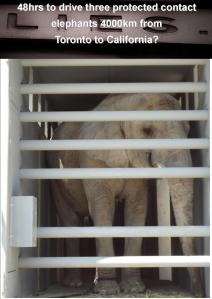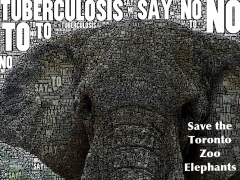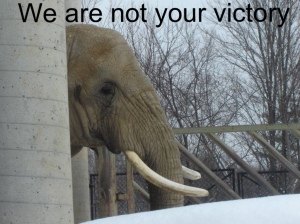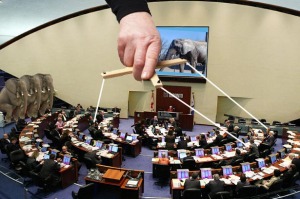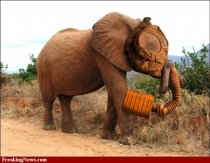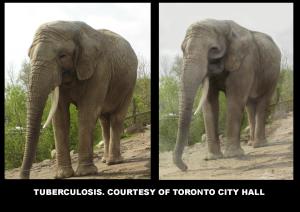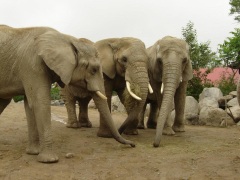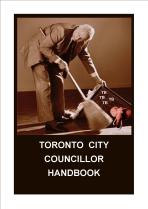If you know anything about politics in the city of Toronto you will
know that our current municipal “leaders” are self proclaimed
legislators of the future, and they legislate according to a future
where they think higher intellect will see zoos as archaic, unnecessary
prisons with little or no value to the education or conservation of
species and their wild habitats. From my personal experience I have
never considered the extremist anti zoo movement to be of a higher
intellect.
Our Zoo board chair
Joe Torzsok, our
CEO John Tracogna
and city councillor/zoo board members have done everything in their
power to cripple our zoo and its efforts to share with the public their
concerns about TB at PAWS. Oppressive social media polices were put in
place, gag orders placed on senior vets and staff. Shut up or lose your
job sums it up nicely. The AZA pulled the
Toronto Zoo’s accreditation citing issues with our
governance.
The AZA came to the zoo board meeting, on USA Thanksgiving in 2011, and
was received poorly. EMA and CAZA came as well, they received the same
reception. Zoocheck kindly offered to spoonfeed City Councillors with
statements for the media denouncing AZA accreditation as less than the standard of PAWS and that the loss of our accreditation was a
bullying tactic by the AZA (pg3)
to force a re-decision on PAWS as a home for the girls; because
according to Zoocheck this was now about zoos vs sanctuaries and the zoo
and its supporters were driving this battle in the name of the AZA and
not because we were and still are concerned about tuberculosis at PAWS.
They did everything they could to deflect from the seriousness of TB on
site.
Here
in PAWS own newsletters from 2012 you can read where they disparage the
Toronto Zoo and the AZA. Of course these are the same people, Zoocheck
and Councillors, who misled the media accusing zoo staff of being
motivated by fear of job loss, see
here and
here – knowing full well that no staff would be losing their jobs.
In January of 2012 a bull elephant named Sabu died at PAWS. As a
result of Sabu’s death a citizen led group called Zoos Matter began
what has become an almost 2 year battle. He had only been there for 18
months and he was just 29 years old. Sabu was one of two elephants and
$270,000.00 which PAWS agreed to take as a result of a
legal settlement
with Ringling Brothers/Feld Entertainment. Red flags were raised. It
took less than a week to hunt down supporting evidence that
Sabu likely died from TB.
His previous owners stated publicly that Sabu showed no signs of
lameness or illness when he left their facility to travel to PAWS.
In an
email
between Zoocheck’s Julie Woodyer and Councillor DeBaeremaeker Zoocheck
claims PAWS had no idea Sabu had TB previously, and that his previous
caregivers, Two Tails Ranch had not told them. Of course anyone who has
researched this would know full well that Sabu’s previous positive
diagnosis for TB 10 years earlier is widely available on the internet
from USDA documents posted by PETA in their media file series on
circuses. By April of 2012 FOIA indicated that in fact Sabu did die TB+,
but prior to that in February Zoos Matter was able to provide enough
evidence so that the Zoo Board and CEO at the very least were required
to allow the zoo vets to investigate this death and other possible TB
deaths at PAWS. Despite these concerns in February of 2012 the zoo and
the zoo board went ahead and signed a
legal agreement
with PAWS. PAWS claimed that Sabu died of severe genetic arthritis and
the tissue cultures would take up to 8 weeks. They never willingly
shared the tissue culture results; these were accessed via Freedom of
Information. Even after the
FOIA evidence
which surfaced in April of 2012 indicated he died TB+ and with not one
but two strains of TB they still claim he died “from euthanasia due to
degenerative bone disease”. Evidence indicates that PAWS knew for some
time that Sabu was actively infected again. In a
blog post
dated July 13, 2011 by a visiting sanctuary owner Karl Cullen he
discusses how Sabu was under full quarantine and that he and staff had
to wear protective masks and gloves. They knew full well Sabu was TB+
was early as the summer of 2011. This was months before council seized
control of the Toronto Zoo elephants and made the decision to send them
to PAWS promising that THERE WAS NO TUBERCULOSIS AT PAWS.
PAWS claim that Sabu had died from severe arthritis was basically a
lie or at the very least not the whole truth. Advanced severe arthritis
was obviously a symptom aggravated by his positive tuberculosis
infection. When the FOIA was finally accessed in April of 2012 it was
proven conclusively that Sabu died TB+. No media outlet called Zoocheck
or the Councillors or PAWS out on why they had publicly maintained for
so long there had been no TB at PAWS when it was clear and evident they
had known for months that he was ill with the disease. That same FOIA
indicated that another Asian elephant named Rebecca had died in January
of 2011 TB+, again with not one but 2 strains of TB. Her second strain
of TB was new to elephants and had no match in the global tuberculosis
databases as per a search done by the CDC. By their own admission in the
graphs included with the Dr. Cork report and in FOIA PAWS and their Vet
Dr. Gai admit Rebecca’s treatments were ceased three years prior to her
death
(here pg. Pg.25/pg.2 of necropsy report)
Further FOIA indicates that prior to her death and the positive
STATPAK reactions of the two herd mates exposed (Annie and Wanda) all
trunk prior trunk washes and STATPAKs had been negative (
here pg. 26-27). Dr. Gai admits that
they had no idea Rebecca
was TB+ until AFTER she died and that no staff wore any protective
gear. The zoos own site visit report indicated this as they were not
allowed to inspect 4 out of the five barns on site at PAWS. It was clear
and evident that the disease prevention protocols at PAWS were in
serious trouble and that our allegations and the concerns of senior zoo
staff and vets were not unfounded. We were able to determine with common
sense, research and then FOIA evidence that two elephants, Annie and
Wanda had been exposed to Rebecca’s TB, Rebecca had not been in
quarantine, again evidenced in
FOIA from California State Health
because PAWS had no clue she was TB+. As a result eventually Annie
converted to active TB in June 2012. How is this NOT a tuberculosis
outbreak? And how is this World Class Bio Security Protocols? According
to Pat Derby’s own accrediting body GFAS they are world class.
Yes, they accredit themselves.
Through freedom of information requests and research we were able to
prove that PAWS actually had a tuberculosis outbreak with TB
transmission on site which included 3 elephants (3 that have been
documented), the transmission was entirely their fault due to bio
security protocol failure as they had
no idea the source elephant was TB+
until after her death. They and their affiliates on council along with
Zoocheck Canada who acts as PAWS agents here in Toronto lied outright to
the media. Zoos Matter did the job City Council failed to do. They also
engaged in a media campaign to disparage and malign the zoo and its
staff to undermine staff motive for opposition, basically to turn people
against the zoo and deflect the media from the real issue at hand,
tuberculosis. The media willingly complied. Staff have been harassed and
stalked on social media by activists who file complaints to the city
and CEO if any staff say anything about this transfer publicly. Senior
vet staff have also been threatened with job loss if they continue to
fight or refuse to sign off on anything PAWS related. City Councillor
Glen DeBaeremaeker even went so far as to encourage the senior vet staff
at the zoo to resign if they felt they were being forced to engage in
unethical activities. He said he would resign if it were him, we wonder
why he has yet to resign considering the lack of ethics of forcing three
healthy animals to a facility with a known disease outbreak simply to
satisfy personal extremist dogma. Meanwhile while Zoocheck and
Councillors had the media focusing on staff issues they were misleading
everyone about tuberculosis at the sanctuary, sort of like how a
magician says look closely at this hand while I trick you with the other
hand.
Now that tuberculosis had been proven on site Zoocheck, PAWS and
Councillors began claiming that the African herd was safe from TB, that
the STATPAK tests and trunk washes for the LIVING elephants were clear.
They were very careful to use the word “living”. Councillors, Zoocheck
and PAWS were quick to state that although they previously
hailed the STATPAK
test as the gold standard in diagnoses of TB and that they were leaders
amongst facilities with elephants using that diagnostic they quickly
changed their tune when FOIA indicated positive Statpak reactions in
Rebecca’s herd mates, they flip flopped and stated trunk washes were
gold standard. Trunk wash is of course an unreliable test and this can
be evidenced
here and
here (elephantcare.org)
, citing
a case in Sweden and a TB outbreak where five elephants were affected.
Of 189 trunk wash samples collected, only 7 were positive from the 5
elephants that were confirmed (on post mortem) to be infected with TB
(Moller 2005, Moller 2006, Lewerin 2005). What is Gold Standard is a
tissue culture, as we know trunk wash is only good if a) the sample is
not contaminated with foreign substances and b) the animal in question
is actually shedding the organism when the trunk wash is conducted
(elephants shed the TB bacilli intermittently so it is hit and miss with
more miss than hit). Furthermore it had been evidenced in the TB case
of Rebecca that an infected animal can show a negative STATPAK result or
the results can be misinterpreted for animals previously infected or
treated and that trunk wash tests failed to diagnose TB at PAWS,
claiming the Afrcian herd is clean means nothing based on the failed
diagnostic history of their Asian herd. On an airing of the television
program The Agenda Councillor
Berardinetti admits she knew about the tuberculosis. Here is a
link
from the Live Chat file from TVO’s The Agenda with arguments and
commentary by Zoocheck Canada’s Julie Woodyer, PAWS supporters vs
Toronto Zoo supporters, well worth the read)
Quarantine Issues
When FOIA documents finally evidenced that in fact there was
tuberculosis on site and that there had been on-site transmission PAWS,
Zoocheck and Councillors began their media campaign claiming that the
elephants in question had been in quarantine and that all proper
procedures had been followed. In a presentation to the Toronto Executive
Committee Meeting in November, 2012
Annie’s likely positive TB status and quarantine issues were brought forward by a deputant as well as evidence of the Africans and Asians
sharing one barn and how it was logistically impossible to quarantine any of the elephants based on the
availability of barn space.
We had reviewed multiple videos, photographs, blogs, news stories, we
left no stone unturned. They claimed the two affected Asians were in
quarantine at a time when Sabu was still alive, we asked the question
where? There was no available barn until Sabu’s death in January of
2013. With one barn for the Africans females, one for the Asians and the
three bull barns all occupied until Sabu’s death they were simply out
of barns. According to the Zoos Site Visit report there is no quarantine
barn at Ark2000. According to that same report the zoo vets and staff
were only allowed to inspect one out of the five barns on site.
Now that Annie is TB+ we imagine she is living alone, likely
in Sabu’s old barn. You know, alone, a lone elephant like the kind of
elephant Zoocheck promotes is being treated inhumanely because they are
sad and lonely. In fact according to The Dr. Cork report despite be
diagnosed as TB+ in June of 2012 Annie had still not been begun
treatments by November 27, 2012, 6 months after her positive diagnosis.
So not only was she living alone but potentially dying from
tuberculosis. We made this public and not one activist organization had
any problem with it. I imagine if a zoo did not treat an animal for 6
months Zoocheck would be outraged. People were certainly outraged when
this recently happened in
France. This news
article mentions the one barn and quarantine of Tinkerbelle. Ruby did not have a proper quarantine, just
10 days after her arrival she was introduced to the African herd, she was able to
touch the other Africans in the barn as soon as she arrived at Ark2000. Evidence of the shared barn can be found
here and
here.
Eventually zoo staff were
denied second site visit by Pat Derby.
Considering they had no idea Rebecca was TB+ when she died and wore
no protective gear and that Rebecca infected 2 other elephants (one of
which is now TB+) and had no physical means to quarantine while Sabu was
still alive (all 5 barns were being used) our concerns over bio
security at PAWS grew with every passing day. It was in fact much more
serious than we had possibly imagined. An extensive research
project was underway to investigate the detailed histories of
each elephant at PAWS. We focused on a particular African elephant named
Ruby who had died three months after Rebecca with no cause of death
determined and who had a high risk history of TB exposure. At the same
time the zoo vet staff were demanding medical histories on the Africans
and PAWS was not cooperating with these requests as evidenced in the
Zoos Transfer status update on
September 25, 2012.
It was at this time PAWS and Zoocheck made some very public media
statements accusing the zoo staff of undertaking unnecessary delays –
unnecessary delays?
Asking for tissue cultures from a deceased African to determine its
disease status at time of death is not unnecessary it is what any
zoological professional should expect and demand. Not having tissue
cultures done for Ruby was the height of unprofessionalism and there is
no logical explanation as to why the cultures were not done. To date
there has been no mention in the media about the missing cultures.
Councillors made numerous claims that our zoo was motivated by pressure
from the AZA not animal welfare, remember the zoo lost its accreditation
due to governance issues. Basically the AZA felt our zoo had no control
over the future and welfare of its animals and the AZA was correct.
Under the guidance of CEO John Tracogna and Zoo Board Chair Joe Torzsok,
pressured by City Council/Councillors/Zoo Board members we had now lost
our AZA accreditation with the potential loss of CAZA and our
government research facility accreditation looming
. Councillors
continued to make many claims in the media disparaging our zoo and its
staff. Evidence via FOIA indicated these councillors again were being
spoon fed statements by Zoochecks Julie Woodyer.
The zoo was finally granted access to the medical documents under
strict guidelines outlined by Zoocheck, only the CEO could review them
he could not take notes or make copies and Zoocheck’s Julie Woodyer had
to be present, Woodyer even requested the meeting be videotaped. Again
citing legal obligations to previous owners they did not want the
information made public. We could not understand what previous owners of
the African elephants were so concerned about. The LA Zoo’s TB outbreak
was widely publicized, San Francisco’s TB troubles were also known.
71’s previous owner had passed away many years ago and Maggie was a lone
elephant from Alaska. Eventually vet staff was allowed to review the
documents as it was clearly ludicrous not to mention suspicious not to
have veterinary staff review the documents. But it was certainly
strategically advantageous for PAWS to maintain the facade of world
class bio security protocols by preventing veterinary experts’ access to
information which might undermine those world class claims. Eventual
FOIA from the University of Calgary evidenced what the vets found in
those reports
According to PAWS and Zoocheck the vet for PAWS at the time of Ruby’s
death was the vet they were parading around as an expert, Dr. Mel
Richardson. The same vet who at the November 2012 City of Toronto
Executive Committee Meeting had no idea how many elephants had died at
PAWS under his supposed watch. That would be 6, in four years. It is
pretty hard to not remember that 6 elephants died while under your
“expert” veterinary care. In fact all the PAWS supporters and deputants
at that meeting were asked the same question; none of them knew the
answer. Dr. Richardson has been involved in cases where he has made
ocular inspections of an animal like Mali, the elephant in Manila Zoo (
here) only to be
disproven by an
IUCN
expert who had access to Mali’s blood sample. Dr. Richardson is a paid
advocate for animal rights groups in the USA and far from impartial.
The zoo demanded the tissue cultures on Ruby, PAWS stated
they had no more medical documents to give. According to Zoo staff PAWS
was uncooperative throughout the entire due diligence process as stated
in the Zoo’s Elephant
Transfer update
released September 25, 2012. FOIA requests to USDA, California Fish and
Game and California Health Department came up empty, proving that no
tissue cultures were ever done on Ruby. Clearly if tissue cultures were
done and TB was found and officially documented in their African herd
PAWs would not currently be in receipt of the Toronto zoo elephants,
they would not have been considered in the first place and likely would
have been restricted by their local and federal agencies from
integrating any new elephants into what is basically their financial
life blood, their African herd at PAWS. Both their Asian and African
herds would be considered high risk for tuberculosis. They would have no
means to accept any new elephants of any species. FOIA indicated that
PAWS had a human case of sero conversion to tuberculosis
(here pg.12). Zoos Matter followed up and accessed the
genotypes (
and here)
for the two current cases of human tuberculosis (as of January 2013) in
Calaveras County. Those genotypes did not match any of the documented
TB strains in PAWS’ elephants but they did match an elephant named
Calle. We followed the elephant trail and easily connected
Calle’s strain of TB
to the African herd and to PAWS through two Asian elephants, Calle
(deceased from tuberculosis) and Tinkerbelle (deceased complications
from chronic foot infections).
Ruby had lived with an Asian elephant named
Gita
at the LA Zoo. After Gita died in June of 2006 Ruby was transferred to
PAWS in May of 2007 where she lived in a shared barn with both the
Asians and Africans until late 2009, all the female elephants shared
this barn since 2004. Detailed reviews of dated photographs, videos and
news articles and in PAWS and
Pat Derby’s own words (
and here) evidence this. LA Zoo had a
TB outbreak
from 1997-2000. Before living with Ruby Gita lived 2 other Asians,
Annie (not PAWS Annie who is now TB+) and Calle. Both Annie and Calle
died from tuberculosis. Annie died on
March 22, 1997
from tuberculosis at the LA Zoo, Calle was transferred to San Francisco
Zoo where she lived with an Asian named Tinkerbelle. Tinkerbelle was
transferred to PAWS in
November 28, 2004 and died just 4 months later from severe foot infections Calle died
March 6, 2004 of tuberculosis at San Francisco Zoo in 2004. Pat Derby can be seen here
handling Tinkerbelle
without proper protective gear. One has to wonder with such compromised
health issues why activists demanded that Tinkerbelle be transferred in
the first place and not humanely euthanized at the zoo. One can only
imagine that perhaps PAWS arrogance drove them to believe they could
magically heal her. Nevertheless there are no tissue cultures for
Tinkerbelle either. One other elephant came from the San Francisco Zoo,
an African named Lulu who currently lives in PAWS African herd. Of the
three remaining Africans at PAWS two are in the same age range as
Toronto’s Thika. PAWS has claimed that our elephants will be their
last. At some point that African herd will be down to 2 then 1, living a
life of solitude. At the National Elephant Center there will always be
family groups of elephants, they will never be alone or die alone.
Without Ruby’s tissue cultures PAWS cannot prove there is no TB in
the African herd. Statpak tests have proven to be useless when animals
have already been exposed or infected to TB (evidenced in Rebecca’s
case) and trunk washes are notoriously unreliable. This is all evidenced
by PAWS own experiences as all trunk washes for Rebecca, Annie and
Wanda
were negative (pg.26-27) even up until Rebecca’s death from tuberculosis. According to the
Dr. Cork report
and the information supplied to them by PAWS, the sanctuary has NEVER
had a positive trunk wash result? How exactly did they diagnose Sabu?
Somehow Rebecca’s STATPAK test was misdiagnosed as she would have had
some kind of reaction due to her past history of exposure and treatment.
Her STATPAK tests would have presented with positive reactions which
must have been misinterpreted as residual from her previous diagnosis
for TB back in 2002.
One has to wonder if Ruby’s Statpak tests,
due to treatment and exposure would have shown some kind of reaction
that was also misdiagnosed.
Imagine their panic when upon
necropsy of Ruby they found a bronchial mass. Not having this cultured
was irresponsible elephant management practise and evidence of bio
security FAILURE. There can only be one explanation as to why cultures
were not done and I will leave that up to you to evaluate.
The evidence of risks of tuberculosis within the African herd at PAWS
is near conclusive. It can only be “near” as there are crucial missing
pieces of medical information which would determine once and for all if
the herd had been exposed; tissue cultures for both Ruby and 71. Toronto
City Council refuses to listen to anything which might challenge their
egos and dogma and our CEO is pandering to council to save his 200k a
year job despite having the
legal right according to the contract to say no on the grounds of tuberculosis. (Item 17).
The entire senior professional staff at the Toronto Zoo is against this
transfer and their professional authority has been overridden by
politicians and animal rights groups. By October 2012 there were threats
of
legal action
against the Toronto Zoo and a Swedish blogger and keeper/creator of the
internet’s most comprehensive database on captive elephants worldwide
had also been
threatened with legal action by PAWS.
On November 5, 2012 by order of the
Toronto Executive Committee council was to re-vote on this issue. You can review some of the deputations from the meeting
here.
You would think with the overwhelming evidence of tuberculosis
transmission on site and the attempts to cover this up and keep it from
the zoo and the people of Toronto that council would have had the good
sense to re-evaluate their earlier decision. Instead Toronto Council
adopted what they claim was an
independent report
stating PAWS bio security was in good stead, The Dr. Cork report. We
have evidence that this report was commissioned by and paid for by
Zoocheck Canada (
here and
here and
here pg.7) and that Dr. Cork based her report entirely on information
supplied to her by PAWS. Council chose this report over the Toronto Zoo staff’s
due diligence report (supporting DD documents
here)
so that they could move forward with the move to PAWS despite the
overwhelming evidence of tuberculosis risks. By doing so Council could
claim the due diligence was complete and then Zoocheck could lobby the
Royal Canadian Air force for a plane and at the same time apply for road
transport permits in case RCAF refused.
The significance of the Dr. Cork report.
The report provided by Dr. Cork was potentially “misleading” based on subsection 11 of Canadian Federal CITES law
WAPPRIITA
, and a proper assessment should be conducted by CANADIAN Federal
authorities or more neutral parties, on the grounds that the USDA sent
two infected/exposed specimens to PAWS (by their own admission) and
might not be the most impartial agency to conduct due diligence
review. (
Here)
The Health of Animals Act states that no person should
conceal the existence of disease .
There are instances where PAWS refused to comply with requests for more
information (tissue cultures) and the failure to allow the Toronto Zoo
vets access to the quarantined barns (
here)
as concealment of disease. We also have evidence of Councillors
misleading the public in the media about tuberculosis at PAWS and going
so far as to claim there was no TB at PAWs at a time when FOIA indicates
there was.
From the get go it was stated by council and the zoo board that
relocation to PAWS would require air transport, that air transport was
the most humane mode of transport for such a long transport distance,
4200km give or take a few hundred for detours. It was never etched in
stone, city motions and rulings do not say air transport only but it was
verbally stated by Councillors and the Zoo staff, the Zoo Board and
quoted in the media, city council meetings and in FOIA correspondence.
- Toronto Zoo Due Diligence (pg.5-6)
- Toronto Zoo Board Meeting Nov.20/2012 (pg.5)
- City Councillor Email Correspondence (pg.8)

